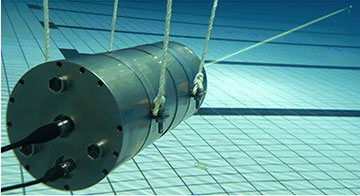
Researchers have developed a single-photon Raman lidar system that operates underwater and can remotely distinguish various substances. The group demonstrated the system by using it to detect varying thicknesses of gasoline oil in a quartz cell that was 12 m away from the system in a large pool. [Image: M. Shangguan et al., Appl. Opt. 62, 5301 (2023); doi: 10.1364/AO.488872]
Detecting subsurface oil in water could help monitor leaks from underwater oil pipelines. Researchers at a Chinese university say they have developed a Raman lidar system that measures the thickness of underwater oil at a distance of up to 12 m (Appl. Opt., doi: 10.1364/AO.488872).
Key to the new device is a highly sensitive single-photon detector that picks up the relatively weak Raman backscattered signal from the petroleum product. Optical fiber connections add to the robustness of the system.
Bringing remote sensing underwater
Although lidar’s remote sensing prowess is usually associated with atmospheric applications, from agricultural surveying to self-driving cars, scientists have been extending its capabilities to the watery realm. Researchers have used two types of underwater lidar: laser-induced fluorescence and Raman spectroscopy. The former can sense chemical spills as well as blooms of phytoplankton and algae. However, fluorescence lidar cannot identify substances that produce similar signals, and rough seas can degrade its performance.
Raman lidar systems can distinguish between oil, dissolved carbon dioxide and other materials in water. The catch: the small cross section of Raman scattering requires a powerful laser and a large-aperture detector, which together make a bulky system that consumes a lot of power.
A team led by Mingjia Schangguan of Xiamen University, China, realized that a single-photon detector would boost the sensitivity of the Raman lidar system.
A team led by Mingjia Schangguan of Xiamen University, China, realized that a single-photon detector would boost the sensitivity of the Raman lidar system. The researchers selected a silicon avalanche photodiode, which would remove the need for a high-voltage power supply.
How underwater Raman lidar works
A pulsed 1064-nm laser seeds the Raman lidar system, but since underwater lidar usually works in the visible band, a postamplification lithium-borate crystal doubles the laser frequency to 532 nm, producing a green beam with a pulse energy of 1 μJ. A 22.4-mm-diameter telescope picks up the backscattered signal and feeds it through a multimode fiber. The signal passes through a pair of filters to block background noise before it hits the compact silicon avalanche photodiode.
To test their prototype, the researchers submerged both the system and a quartz cell containing gasoline 0.6 m under water in a large pool and positioned them 12 m apart. The system successfully detected the oil and was able to distinguish its varying thicknesses, which ranged from 1 mm to 15 mm.
According to the research team, the prototype system used only a single-wavelength channel. More spectral filters and channels would be needed to differentiate between different types of petroleum products and other substances.
The Xiamen group would like to build a system using blue laser light to reduce the fluorescence signal from chlorophyll in algae, which interferes with the Raman backscattered signal from oil.
The Xiamen group would like to build a system using blue laser light to reduce the fluorescence signal from chlorophyll in algae, which interferes with the Raman backscattered signal from oil. Integrating the lidar system into an autonomous underwater vehicle would make it easier to use the device to inspect deep pipelines.

